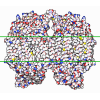+ データを開く
データを開く
- 基本情報
基本情報
| 登録情報 | データベース: PDB / ID: 7n9z | |||||||||||||||||||||||||||||||||||||||
|---|---|---|---|---|---|---|---|---|---|---|---|---|---|---|---|---|---|---|---|---|---|---|---|---|---|---|---|---|---|---|---|---|---|---|---|---|---|---|---|---|
| タイトル | E. coli cytochrome bo3 in MSP nanodisc | |||||||||||||||||||||||||||||||||||||||
 要素 要素 |
| |||||||||||||||||||||||||||||||||||||||
 キーワード キーワード | MEMBRANE PROTEIN / Ubiquinone / Heme-copper Oxidoreductase / Electron transport / Bioenergetics / Proton pump | |||||||||||||||||||||||||||||||||||||||
| 機能・相同性 |  機能・相同性情報 機能・相同性情報cytochrome bo3 ubiquinol oxidase activity => GO:0009486 / ubiquinol oxidase (H+-transporting) / cytochrome bo3 ubiquinol oxidase activity / aerobic electron transport chain / : / oxidoreductase activity, acting on diphenols and related substances as donors, oxygen as acceptor / cytochrome-c oxidase activity / electron transport coupled proton transport / membrane => GO:0016020 / ATP synthesis coupled electron transport ...cytochrome bo3 ubiquinol oxidase activity => GO:0009486 / ubiquinol oxidase (H+-transporting) / cytochrome bo3 ubiquinol oxidase activity / aerobic electron transport chain / : / oxidoreductase activity, acting on diphenols and related substances as donors, oxygen as acceptor / cytochrome-c oxidase activity / electron transport coupled proton transport / membrane => GO:0016020 / ATP synthesis coupled electron transport / aerobic respiration / copper ion binding / heme binding / plasma membrane 類似検索 - 分子機能 | |||||||||||||||||||||||||||||||||||||||
| 生物種 |  | |||||||||||||||||||||||||||||||||||||||
| 手法 | 電子顕微鏡法 / 単粒子再構成法 / クライオ電子顕微鏡法 / 解像度: 2.19 Å | |||||||||||||||||||||||||||||||||||||||
 データ登録者 データ登録者 | Vallese, F. / Clarke, O.B. | |||||||||||||||||||||||||||||||||||||||
 引用 引用 |  ジャーナル: Proc Natl Acad Sci U S A / 年: 2021 ジャーナル: Proc Natl Acad Sci U S A / 年: 2021タイトル: Cryo-EM structures of cytochrome reveal bound phospholipids and ubiquinone-8 in a dynamic substrate binding site. 著者: Jiao Li / Long Han / Francesca Vallese / Ziqiao Ding / Sylvia K Choi / Sangjin Hong / Yanmei Luo / Bin Liu / Chun Kit Chan / Emad Tajkhorshid / Jiapeng Zhu / Oliver Clarke / Kai Zhang / Robert Gennis /   要旨: Two independent structures of the proton-pumping, respiratory cytochrome ubiquinol oxidase (cyt ) have been determined by cryogenic electron microscopy (cryo-EM) in styrene-maleic acid (SMA) ...Two independent structures of the proton-pumping, respiratory cytochrome ubiquinol oxidase (cyt ) have been determined by cryogenic electron microscopy (cryo-EM) in styrene-maleic acid (SMA) copolymer nanodiscs and in membrane scaffold protein (MSP) nanodiscs to 2.55- and 2.19-Å resolution, respectively. The structures include the metal redox centers (heme , heme , and Cu), the redox-active cross-linked histidine-tyrosine cofactor, and the internal water molecules in the proton-conducting D channel. Each structure also contains one equivalent of ubiquinone-8 (UQ8) in the substrate binding site as well as several phospholipid molecules. The isoprene side chain of UQ8 is clamped within a hydrophobic groove in subunit I by transmembrane helix TM0, which is only present in quinol oxidases and not in the closely related cytochrome oxidases. Both structures show carbonyl O1 of the UQ8 headgroup hydrogen bonded to D75 and R71 In both structures, residue H98 occupies two conformations. In conformation 1, H98 forms a hydrogen bond with carbonyl O4 of the UQ8 headgroup, but in conformation 2, the imidazole side chain of H98 has flipped to form a hydrogen bond with E14 at the N-terminal end of TM0. We propose that H98 dynamics facilitate proton transfer from ubiquinol to the periplasmic aqueous phase during oxidation of the substrate. Computational studies show that TM0 creates a channel, allowing access of water to the ubiquinol headgroup and to H98. | |||||||||||||||||||||||||||||||||||||||
| 履歴 |
|
- 構造の表示
構造の表示
| ムービー |
 ムービービューア ムービービューア |
|---|---|
| 構造ビューア | 分子:  Molmil Molmil Jmol/JSmol Jmol/JSmol |
- ダウンロードとリンク
ダウンロードとリンク
- ダウンロード
ダウンロード
| PDBx/mmCIF形式 |  7n9z.cif.gz 7n9z.cif.gz | 449.7 KB | 表示 |  PDBx/mmCIF形式 PDBx/mmCIF形式 |
|---|---|---|---|---|
| PDB形式 |  pdb7n9z.ent.gz pdb7n9z.ent.gz | 369.5 KB | 表示 |  PDB形式 PDB形式 |
| PDBx/mmJSON形式 |  7n9z.json.gz 7n9z.json.gz | ツリー表示 |  PDBx/mmJSON形式 PDBx/mmJSON形式 | |
| その他 |  その他のダウンロード その他のダウンロード |
-検証レポート
| 文書・要旨 |  7n9z_validation.pdf.gz 7n9z_validation.pdf.gz | 1.8 MB | 表示 |  wwPDB検証レポート wwPDB検証レポート |
|---|---|---|---|---|
| 文書・詳細版 |  7n9z_full_validation.pdf.gz 7n9z_full_validation.pdf.gz | 1.8 MB | 表示 | |
| XML形式データ |  7n9z_validation.xml.gz 7n9z_validation.xml.gz | 55 KB | 表示 | |
| CIF形式データ |  7n9z_validation.cif.gz 7n9z_validation.cif.gz | 77.4 KB | 表示 | |
| アーカイブディレクトリ |  https://data.pdbj.org/pub/pdb/validation_reports/n9/7n9z https://data.pdbj.org/pub/pdb/validation_reports/n9/7n9z ftp://data.pdbj.org/pub/pdb/validation_reports/n9/7n9z ftp://data.pdbj.org/pub/pdb/validation_reports/n9/7n9z | HTTPS FTP |
-関連構造データ
| 関連構造データ |  24265MC  7cubC  7cuqC  7cuwC C: 同じ文献を引用 ( M: このデータのモデリングに利用したマップデータ |
|---|---|
| 類似構造データ | |
| 電子顕微鏡画像生データ |  EMPIAR-10737 (タイトル: Cryo-EM structures of E. coli cytochrome bo3 in MSP Nanodiscs EMPIAR-10737 (タイトル: Cryo-EM structures of E. coli cytochrome bo3 in MSP NanodiscsData size: 851.4 Data #1: Unaligned multi-frame micrographs of cyt bo3 in MSP Nanodiscs [micrographs - multiframe]) |
- リンク
リンク
- 集合体
集合体
| 登録構造単位 | 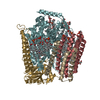
|
|---|---|
| 1 |
|
- 要素
要素
-Cytochrome o ubiquinol oxidase, subunit ... , 2種, 2分子 FI
| #1: タンパク質 | 分子量: 74424.469 Da / 分子数: 1 / 由来タイプ: 天然 / 由来: (天然)  参照: UniProt: H4KCU1, 酸化還元酵素; ジフェノール類縁体を供与体とする; 酸素が電子受容体 |
|---|---|
| #4: タンパク質 | 分子量: 12037.402 Da / 分子数: 1 / 由来タイプ: 天然 / 由来: (天然)  参照: UniProt: I2RK84, 酸化還元酵素; ジフェノール類縁体を供与体とする; 酸素が電子受容体 |
-タンパク質 , 2種, 2分子 GH
| #2: タンパク質 | 分子量: 34947.203 Da / 分子数: 1 / 由来タイプ: 天然 / 由来: (天然)  |
|---|---|
| #3: タンパク質 | 分子量: 22642.566 Da / 分子数: 1 / 由来タイプ: 天然 / 由来: (天然)  |
-非ポリマー , 9種, 267分子 

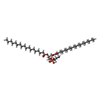


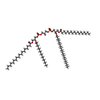
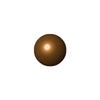










| #5: 化合物 | ChemComp-UQ8 / | ||||||||||||||
|---|---|---|---|---|---|---|---|---|---|---|---|---|---|---|---|
| #6: 化合物 | ChemComp-LHG / #7: 化合物 | #8: 化合物 | ChemComp-HEO / | #9: 化合物 | ChemComp-HEM / | #10: 化合物 | ChemComp-CDL / | #11: 化合物 | ChemComp-CU / | #12: 化合物 | ChemComp-ZN / | #13: 水 | ChemComp-HOH / | |
-詳細
| 研究の焦点であるリガンドがあるか | Y |
|---|---|
| Has protein modification | N |
-実験情報
-実験
| 実験 | 手法: 電子顕微鏡法 |
|---|---|
| EM実験 | 試料の集合状態: PARTICLE / 3次元再構成法: 単粒子再構成法 |
- 試料調製
試料調製
| 構成要素 | 名称: Cytochrome bo 3 ubiquinol oxidase / タイプ: COMPLEX / Entity ID: #1-#4 / 由来: NATURAL | ||||||||||||
|---|---|---|---|---|---|---|---|---|---|---|---|---|---|
| 分子量 | 実験値: NO | ||||||||||||
| 由来(天然) | 生物種:  | ||||||||||||
| 緩衝液 | pH: 7.4 | ||||||||||||
| 緩衝液成分 |
| ||||||||||||
| 試料 | 濃度: 2.6 mg/ml / 包埋: NO / シャドウイング: NO / 染色: NO / 凍結: YES | ||||||||||||
| 試料支持 | グリッドの材料: GOLD / グリッドのサイズ: 300 divisions/in. / グリッドのタイプ: UltrAuFoil R0.6/1 | ||||||||||||
| 急速凍結 | 装置: FEI VITROBOT MARK IV / 凍結剤: ETHANE / 湿度: 100 % / 凍結前の試料温度: 277 K |
- 電子顕微鏡撮影
電子顕微鏡撮影
| 実験機器 |  モデル: Titan Krios / 画像提供: FEI Company |
|---|---|
| 顕微鏡 | モデル: FEI TITAN KRIOS |
| 電子銃 | 電子線源:  FIELD EMISSION GUN / 加速電圧: 300 kV / 照射モード: FLOOD BEAM FIELD EMISSION GUN / 加速電圧: 300 kV / 照射モード: FLOOD BEAM |
| 電子レンズ | モード: BRIGHT FIELD |
| 撮影 | 電子線照射量: 58 e/Å2 / フィルム・検出器のモデル: GATAN K3 (6k x 4k) |
- 解析
解析
| ソフトウェア | 名称: PHENIX / バージョン: 1.19.2_4158: / 分類: 精密化 | ||||||||||||||||||||||||
|---|---|---|---|---|---|---|---|---|---|---|---|---|---|---|---|---|---|---|---|---|---|---|---|---|---|
| EMソフトウェア | 名称: PHENIX / カテゴリ: モデル精密化 | ||||||||||||||||||||||||
| CTF補正 | タイプ: PHASE FLIPPING AND AMPLITUDE CORRECTION | ||||||||||||||||||||||||
| 3次元再構成 | 解像度: 2.19 Å / 解像度の算出法: FSC 0.143 CUT-OFF / 粒子像の数: 94681 / 対称性のタイプ: POINT | ||||||||||||||||||||||||
| 原子モデル構築 | PDB-ID: 1FFT Accession code: 1FFT / Source name: PDB / タイプ: experimental model | ||||||||||||||||||||||||
| 精密化 | 最高解像度: 2.19 Å | ||||||||||||||||||||||||
| 拘束条件 |
|
 ムービー
ムービー コントローラー
コントローラー









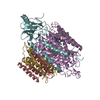
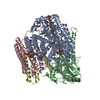
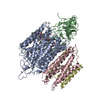
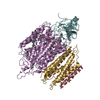
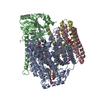
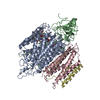
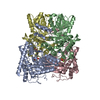
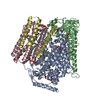
 PDBj
PDBj